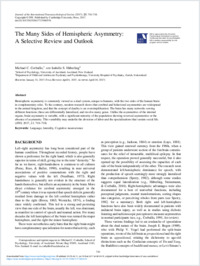The Many Sides of Hemispheric Asymmetry: A Selective Review and Outlook.
- Corballis MC 1School of Psychology,University of Auckland,Auckland,New Zealand.
- Häberling IS 2Department of Child and Adolescent Psychiatry and Psychotherapy,University Hospital of Psychiatry,Zurich,Switzerland.
- 2017-12-05
Published in:
- Journal of the International Neuropsychological Society : JINS. - 2017
English
Hemispheric asymmetry is commonly viewed as a dual system, unique to humans, with the two sides of the human brain in complementary roles. To the contrary, modern research shows that cerebral and behavioral asymmetries are widespread in the animal kingdom, and that the concept of duality is an oversimplification. The brain has many networks serving different functions; these are differentially lateralized, and involve many genes. Unlike the asymmetries of the internal organs, brain asymmetry is variable, with a significant minority of the population showing reversed asymmetries or the absence of asymmetry. This variability may underlie the divisions of labor and the specializations that sustain social life. (JINS, 2017, 23, 710-718).
- Language
-
- English
- Open access status
- green
- Identifiers
-
- DOI 10.1017/S1355617717000376
- PMID 29198268
- Persistent URL
- https://sonar.ch/global/documents/259638
Statistics
Document views: 5
File downloads:
- fulltext.pdf: 0
